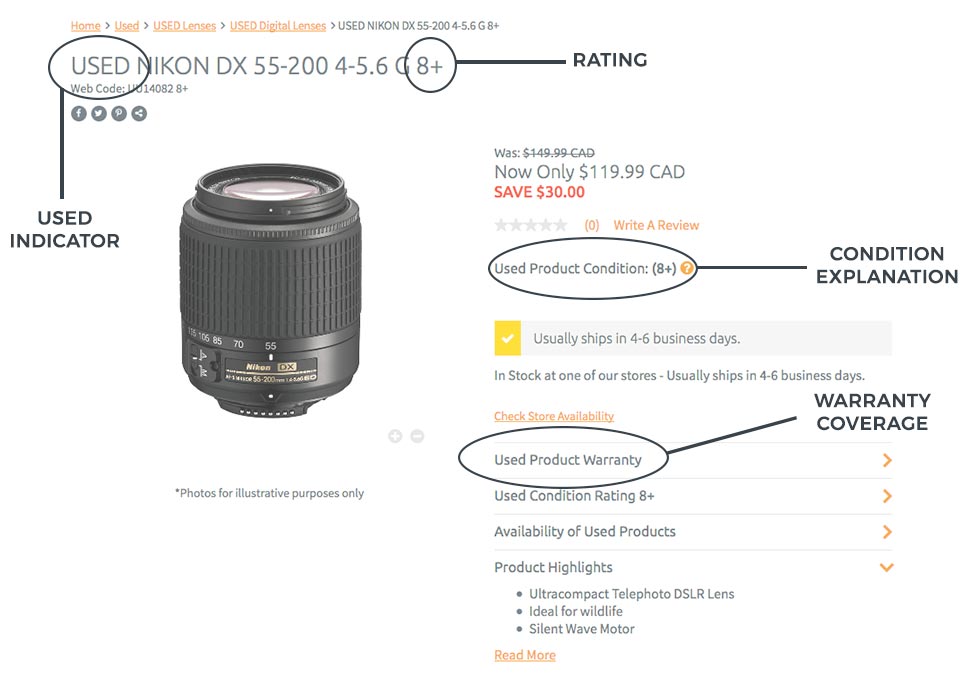Buying a used lens does not have to be a risky proposition. Use these tips to get a great lens and save money at the same time!
Why Buy Used?
Let’s all face a couple of facts. When we buy a brand-new lens, we get one that has been used minimally, with only a couple of mountings to validate that it is working as designed. Quality control is superb and the probability of getting a bad lens out of the factory is very small indeed. However, as soon as we leave the store, the saleable value of the lens drops because the lens is now “used”.
Let’s think a bit about what that means. In a common lens of today, we have a mounting ring, an autofocus motor system, an aperture control, perhaps a zoom system and a manual focus override for the AF. Not a ton of stuff is happening here. We go to make a shot and the AF system activates the motors to bring the image into focus. When we press through to release the shutter, the aperture stops down to the selected aperture and when the shot is over, opens up to maximum again. Zooming tends to be a manual process, and the use of manual focus in AF lenses is actually pretty limited.
What could go wrong then? When a lens ceases to work properly, the vast majority of the time it is through misuse. We will see mounts that have been bent or in the case of the plastic flanged mounts, sometimes broken off. This is not a manufacturer’s defect, it is caused by a user not mounting or dismounting the lens properly. If a lens does not focus, or the zoom feels like dragging a cannonball over sandpaper, or the aperture ring is stuck, invariably this is a result of the lens getting hit, such as when going through a doorway or being dropped.
These things can happen and as a result, most of us are cautious about buying used.

An Alternative Way to Buy Used
A professional camera store will often offer used products. At Henry’s, there is a substantial range of used equipment available for sale because the company and the customers see the value here.
When one considers a used product from Henry’s, it’s good to know that it has been inspected by the person accepting the lens to the used program, and also by the leadership team that handles all used equipment and by the service advisors to rate the product in terms of quality. Not every piece of equipment that comes into the company as used ends up in the used department. When you look on the Henry’s website or at the used selection in the stores, you will always see a rating number. The rating is out of ten, and for resale, the product must be at least an eight out of ten or better. Products that do not meet these criteria do not go into regular used inventory. Looking at the items, we find lots of eights, lots of eight-plus and some nine ratings. What this means is a lens that is functionally new, but that may show some cosmetic wear. It does not mean that there are any defects in the lens.

I know this myself having bought a number of used lenses from Henry’s. My tilt/shift, my 300/2.8, my 400/4 DO and my 500/4 all came from Henry’s used pool. I have saved literally thousands of dollars on the cost of brand-new lenses, never had a bad experience and have been able to own lenses that on a new purchase I would never be able to afford.
Used can also be a great way to get a lens that is no longer in production but that still fits your use cases. I’ve done this more than once as well.
Tips to Use When Buying a Used Lens
Here are the steps that I and most pros use when checking out used lenses.
- Inspect the front element for scratches and scuffs. They would produce areas of softness in an image.
- Inspect the rear element for scratches and scuffs. Marks here will be more debilitating to an image.
- Hold the lens up to the light and look through it. You are looking for excessive spots on internal elements. The spots could be dust, or they could be pieces of internal anti-reflective materials. Some dust spots are to be expected. You are looking for a lot of spots. If you don’t see them, the lens is fine.
- If you can get the aperture to close down, check the aperture leaves for signs of oil. This can cause an aperture to be slow in changing and could make for inaccurate exposures.
- Move the zoom and the focus rings manually, and make sure that they are smooth without any binding. If you feel binding, this is not a lens that you want to buy as it means that the lens has been hit, or that some foreign matter like beach sand has worked its way into the mechanism.
- Check the lens mount to be sure it matches a new lens. Some minor marks are to be expected, but no flange elements can be bent or broken. Sadly, I have seen some private sales where the heavy metal mount was damaged by forced removal and while the lens could be mounted, it was stiff to mount, and the camera could not focus the damaged lens properly. Make sure that the lens can be mounted and can be dismounted easily without binding. If the mount binds, move on.
- Check the body of the lens for excessive cosmetic wear. This may not be an indicator of the lens not being great, but it might be an indicator of hard use, such as for journalism, or a rental product. You may choose to look for a different product.
- Look through the lens again and examine the individual elements for signs of foreign material buildup. When this exists, it’s usually mould and indicates very poor storage over time. You do not want this.
Of course, if you are ordering online, you cannot do these tests until you receive the lens, so at that point, it would be critical to be able to easily return the product for refund, wouldn’t it? This can go from a challenge to impossible on a private web sale.
You are highly unlikely to find any of these issues when buying a used lens from Henry’s.
When you buy a used lens from Henry’s you have a period where you can return the lens for a full refund, so get out and shoot images right away and confirm that you are getting what you expect from the lens. While it is unlikely that you will find a technical issue, it’s possible that it’s not the lens for you and then at least you can return it towards a lens that better serves your needs. The other thing to note is that when you buy privately, there is no return option and no warranty. Henry’s provides a 90-Day Warranty on used equipment and you can always add the comprehensive H.E.L.P. service package to extend this warranty for up to three years.
Conclusions
You can save significant money when purchasing used lenses from Henry’s. The more expensive the lens was new, the more your savings will be on the used market, that’s just how it works. I have heard people say that a used lens from a store costs more than a used lens privately. It’s often true, but don’t forget to consider what you don’t get on a private sale, such as a return option and product warranty. Sometimes the perceived savings in a private sale are not savings at all.
Have specific questions? Call a store to speak directly with one of our Henry’s experts or send us a message online via live chat, available 7 days a week.


